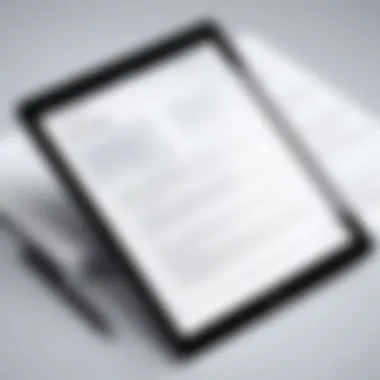Comprehensive Guide to E-Readers and EPUB Format


Intro
The realm of digital reading has expanded significantly with the advent of e-readers and digital formats like EPUB. As technology advances, consumers seek devices that not only cater to their reading habits but also offer versatility in their functionalities. This guide aims to peel back the layers on e-readers, exploring their benefits, key features, and the rise of the EPUB format. We will delve into how EPUB has become a cornerstone in digital publishing. Within this guide, expect thorough breakdowns of leading e-readers, comparisons of significant models, and insights into the creation and optimization of EPUB files.
The intention is to equip both tech enthusiasts and casual readers with valuable knowledge, promoting a deeper understanding of e-readers and the nuances of EPUB files.
Product Overview
When considering e-readers, it is vital to evaluate their design and features. The standout devices in the market offer various functionalities tailored for different reading preferences.
Description of the Product
E-readers are specialized electronic devices designed explicitly for reading digital books, magazines, and documents. Highly portable, these devices often include features such as touchscreen interfaces, adjustable front lights, and compatibility with multiple file formats.
Key Features and Specifications
A quality e-reader typically presents certain features:
- Display: E Ink technology creates a paper-like reading experience, reducing eye strain.
- Battery Life: Many models extend battery life over weeks, making them suitable for long-term use.
- Storage Capacity: With options ranging from 8GB to 32GB or more, there is ample room for thousands of books.
- Connectivity: Wi-Fi and Bluetooth functionalities allow users to download books and sync across devices.
- File Support: The ability to read various formats, particularly EPUB, enhances usability.
In-Depth Review
An analysis of e-readers covers performance and usability, crucial for discerning readers. Each aspect can significantly affect the overall experience.
Performance Analysis
The performance of e-readers can be judged based on speed, screen clarity, and responsiveness. Fast page turns, high resolution, and minimal latency contribute to a seamless reading experience. Brands like Amazon Kindle Oasis and Kobo Clara HD utilize advanced technology to ensure efficient operation.
Usability Evaluation
Usability pertains to how easy it is for users to interact with the device. Factors include:
- Interface Navigation: A user-friendly interface is key for readers to find and organize their books.
- Portability: Lightweight designs improve convenience for readers on the go.
"In the evolving landscape of digital literature, understanding the tools and formats enhances one's reading adventure."
This guide aims to illuminate the attributes of e-readers and clarify the importance of EPUB format, ensuring readers can make informed choices in their reading journeys.
Intro to E-Readers
E-readers represent a transformative shift in how literature and other written content are consumed. They combine technology with reading, merging the experience of traditional books with the advancements of digital formats. This section highlights the significance of e-readers within the broader context of digital media consumption.
Definition and Purpose
E-readers, or electronic readers, are portable devices designed primarily for reading digital e-books and other digital publications. Their primary purpose is to provide a reading experience similar to printed books but in a more convenient form. Many models in the market, such as the Kindle or Kobo, use e-ink technology. This technology mimics the appearance of ink on paper, reducing eye strain while enhancing readability in various lighting conditions.
The functionality of e-readers also extends beyond mere reading. They often come equipped with features like adjustable font sizes, built-in dictionaries, and note-taking capabilities. These options cater to diverse reading preferences and styles, making e-readers increasingly popular among avid readers.
Evolution of E-Readers
The development of e-readers can be traced back to the late 1990s. Early models, like the Rocket eBook and SoftBook, laid the groundwork for more advanced devices. However, it was the introduction of the Amazon Kindle in 2007 that marked a significant milestone in the evolution of e-readers. The Kindle offered a simple buying experience and vast catalog of books, allowing users to download titles wirelessly.
As technology progressed, so did the e-reader features. The emergence of touch screens, backlit displays, and enhanced battery life contributed to the functionality and user experience. Readers can now access vast libraries, often thousands of books on a single device, offering unprecedented convenience. Manufacturers have also recognized the need for a diverse range of devices, leading to various form factors and functionalities tailored to specific audiences.
[E-readers have successfully integrated modern technology with the age-old pleasure of reading, providing easier access to literature and changing reading habits.]
Through this evolution, the role of e-readers has expanded significantly. They serve not just as devices for reading but also as platforms for cultural exchange, education, and content consumption. The continuous advancements in associated technologies signal a promising future for e-reading.


Understanding the EPUB Format
The EPUB format represents a significant advancement in digital publishing. It allows for flexible and responsive design, enabling text to adjust to various screen sizes. This adaptability makes EPUB a go-to choice for e-book authors and publishers aiming for a wider audience reach. Understanding this format is essential for both readers who wish to access content seamlessly, and for creators who are looking to optimize their publications for diverse platforms.
Technical Characteristics of EPUB
EPUB is an open standard that incorporates a range of technologies, including XHTML, CSS, and XML, to structure content. The core components include:
- Reflowable Content: This enables text to flow optimally regardless of the device's screen size.
- Support for Multimedia: EPUB files can include images, audio, and even video content, enhancing the reading experience.
- Interactivity: Users can engage with annotations, hyperlinks, and forms, elevating the interaction level within e-books.
These technical elements combine to create a robust format that suits various reading preferences. It also supports DRM (Digital Rights Management) to protect copyright, which has become increasingly important in the digital age.
Advantages of Using EPUB
The EPUB format offers numerous benefits which cater to a diverse user base:
- Cross-Device Compatibility: EPUB files are accessible on various e-readers and software, enhancing user convenience.
- Ease of Creation: Many tools are available for authors, allowing easy conversion from other formats to EPUB.
- Accessibility Features: EPUB supports features for disabled readers, such as text-to-speech capabilities and customizable display options, making literature available to a wider audience.
- Cost-Effective Publishing: Since EPUB is an open standard, it eliminates high licensing fees, allowing authors to publish efficiently.
These advantages position EPUB as a leading choice in the e-publishing landscape, making it essential for anyone involved in digital content.
Challenges with EPUB Files
Despite its numerous benefits, there are challenges associated with the EPUB format:
- Complexity in Formatting: Authors may struggle to maintain formatting consistency across different devices.
- Limited Support with Certain Software: Not all e-readers support EPUB, limiting accessibility. For example, Amazon Kindle primarily uses its proprietary format, MOBI.
- Potential for Poor Quality: Not all EPUB creations maintain high-quality standards, leading to subpar user experiences.
While these challenges exist, they are often manageable with proper tools and knowledge about the EPUB ecosystem.
"Understanding the EPUB format is crucial for navigating the complex landscape of digital publishing effectively."
In summary, a solid grasp of the EPUB format is essential for anyone engaging with e-books. The potential benefits far outweigh the challenges, making it a worthwhile endeavor for both readers and content creators.
Key Features of E-Readers
Understanding the key features of e-readers is essential for both potential buyers and technology enthusiasts. These features not only define the functionality and usability of the device but also enhance the overall reading experience. E-readers offer unique advantages over traditional media, and knowing their fundamental attributes assists users in making informed choices.
Display Technologies
The display technology used in e-readers is one of the most significant factors influencing a user’s reading experience. Most e-readers utilize E Ink technology, which mimics the appearance of ink on paper, making it easier to read for extended periods without strain. This technology offers several benefits:
- Glare-free reading: E Ink displays do not reflect as much light as traditional screens, enabling comfortable reading in bright sunlight.
- Energy efficiency: E Ink screens consume power primarily when changing pages, which lengthens battery life significantly.
- High contrast: These displays generally provide better contrast with text, enhancing readability.
Several e-readers also feature front lighting systems, allowing users to read in darker environments. Adjustments to brightness levels can be made, ensuring a tailored reading experience.
Storage Capacity
Storage capacity in e-readers is a crucial consideration, especially for users who desire versatile libraries. A majority of modern e-readers come with built-in storage ranging from 4 GB to 32 GB or more. This capacity allows users to store thousands of books, ensuring they are always available, whether at home or on the go.
- Expandable storage: Some models, like select Kobo devices, offer options for microSD cards, enabling users to expand their storage further.
- Cloud integrations: Many e-readers include synchronization with cloud services, allowing users to access their libraries across multiple devices without worrying about storage limits.
Understanding the storage options available helps users select an e-reader that will meet their future reading needs without the hassle of managing limited space.
Battery Life and Charging
Battery life is a pivotal aspect of e-readers, directly impacting user experience. E-readers typically boast exceptional battery longevity, with most devices lasting several weeks on a single charge, depending on usage. This extended battery life is a significant advantage over smartphones and tablets that require frequent recharging.
- Charging methods: Most e-readers utilize USB charging, making it convenient for users to charge via computers or portable power sources.
- Battery-saving features: Many e-readers come equipped with power-saving modes and settings that adjust screen brightness or refresh rates to optimize battery life further.


The combination of prolonged battery performance with practical charging options makes e-readers appealing for avid readers who wish to enjoy uninterrupted reading sessions.
In summary, the key features of e-readers—display technologies, storage capacity, and battery life—collectively enhance their functionality, making them superior to traditional books in various scenarios.
Popular E-Reader Devices
The discussion of popular e-reader devices is critical for understanding the landscape of digital reading technology. As e-readers become more prevalent, consumers need to be informed about the leading options available in the market. Each device offers unique advantages, making them suitable for different preferences and reading habits. In this section, we will focus on three major players in the e-reader market: Amazon Kindle Series, Kobo e-Readers, and Barnes & Noble Nook. Understanding these devices helps readers select a technology that aligns with their needs and enhances their reading experience.
Amazon Kindle Series
The Amazon Kindle Series remains a definitive name in the realm of e-readers. With various models such as the Kindle Paperwhite and Kindle Oasis, Amazon has designed devices to cater to diverse user needs, from casual readers to dedicated bibliophiles. The series is well-regarded for its integration with the Amazon ecosystem, allowing seamless purchasing and downloading of eBooks. A standout feature is its vast collection of titles, which includes many exclusive offers.
Users appreciate features like impressive battery life and adjustable front lights that improve readability in various environments. Additionally, features like Kindle Unlimited provide subscription access to a wide library of titles, which is an attractive option for avid readers. The lightweight design is also a considerable advantage, making long reading sessions more comfortable.
Kobo E-Readers
Kobo e-Readers are gaining recognition for their commitment to openness and user-friendly features. Unlike Kindle’s closed ecosystem, Kobo supports a wide range of formats beyond EPUB, including PDF, which adds flexibility to the user experience. Models such as the Kobo Clara HD and Kobo Forma showcase excellent display quality, equipped with features like ComfortLight that allows for easy nighttime reading.
A notable aspect of Kobo devices is their integration with local libraries through the OverDrive system, which enables users to borrow eBooks easily. This feature significantly expands the reading options without the need for additional purchases. Furthermore, Kobo emphasizes user control, offering customizable reading settings that can be tailored for optimal comfort.
Barnes & Noble Nook
The Barnes & Noble Nook also contributes to the e-reader market with its distinct positioning. It emphasizes a user-friendly interface and syncs well with the Barnes & Noble ecosystem. The Nook series includes the Nook GlowLight 3 and Nook Color, which cater to different reading preferences. Users often find the touchscreen interface straightforward, making navigation seamless for both older adults and tech-savvy users alike.
Another important element is the support for both EPUB and PDF formats. This means readers can easily access a variety of content, further enhancing the Nook's appeal. The built-in Barnes & Noble bookstore provides a direct line to thousands of book titles. In addition, the Nook devices support features such as Night Mode to make reading easier in low light.
"Choosing the right e-reader is about finding the device that matches your reading habits and preferences. It's not just about technology; it's about making reading more enjoyable."
In summary, each of these e-reader devices offers distinctive features and capabilities. While Amazon Kindle leads with a large library and ecosystem, Kobo offers versatility with format support and library integration. The Barnes & Noble Nook focuses on simplicity and user experience. Knowing these factors helps readers make informed choices that align with their preferences.
EPUB File Creation and Optimization
Creating and optimizing EPUB files is crucial for anyone involved in digital publishing. This segment not only covers the essentials of producing EPUB files but also delves into the importance of optimizing them for various e-readers and user experiences. An optimized EPUB ensures that readers engage with content effectively, enjoying a seamless experience across multiple devices.
Basic Guidelines for EPUB Creation
Creating an EPUB file involves understanding specific guidelines to guarantee compatibility and functionality. Here are the key points to consider:
- Use Standard File Structures: Ensure that your EPUB includes essential files such as , , and directories. Each of these plays a vital role in how the EPUB is recognized and displayed.
- Keep Media Formats Simple: When embedding images or audio, stick to widely accepted formats. JPEG for images and MP3 for audio are preferred, as they are universally compatible.
- Test Across Different E-Readers: Before finalizing your file, test it on multiple devices and applications. Each platform may display the content differently, so adjustments may be necessary.
- Maintain Clean Code: Avoid excessive formatting and ensure your HTML is well-structured. Clean code not only reduces file size but also enhances readability on various devices.
"A well-built EPUB file enhances the reading experience and reduces potential errors during reading."
Tools for EPUB Development
Various tools can assist in the creation and optimization of EPUB files. Some popular options include:
- Calibre: An open-source e-book management tool that allows for conversion and editing of EPUB files. Its capabilities range from basic to advanced, making it versatile for different skill levels.
- Sigil: A dedicated EPUB editing software that offers a user-friendly interface. It supports WYSIWYG (What You See Is What You Get) editing, making it easier for those less familiar with code.
- Adobe InDesign: This professional design software provides powerful features for creating layout-rich EPUB files, especially useful for publications that require visual elements.
- Pandoc: A command-line tool that enables the conversion of documents into EPUB format. It's highly flexible and supports numerous document formats.
Reading Experience on E-Readers
The reading experience on e-readers is essential to understanding the overall utility and appeal of these devices. As they become more prevalent, consumers often seek optimal conditions for engagement with digital literature. It is not just about having a device that can display text. The quality of the reading experience involves multiple detailed aspects, including user interface design, customization options, and interaction with the content. These elements all contribute to how effectively users can enjoy and engage with materials across various genres and formats.
User Interface Considerations
User interface is a pillar in the reading experience on e-readers. A well-designed interface facilitates seamless navigation. Users should easily find books, change settings, and access other features. Intuitive design not only enhances usability but also minimizes frustration. Many e-readers offer touchscreens, which allow for simple page flipping and annotation. However, the quality of this experience varies by device.
- Clarity and Responsiveness: A crisp display improves readability. Touchscreen responsiveness can affect how quickly actions are executed.
- Navigation and Menus: Simple and logical menu structures prevent users from feeling overwhelmed. E-readers with advanced search functions offer users the ability to locate specific passages or themes without manual scrolling.
- Accessibility Features: Devices catering to diverse user needs can include voice output options or adjustable text size. These inclusions can significantly enhance the experience for readers with visual impairments.


The interface must encompass all user needs while staying streamlined. An effective user interface enriches the reading experience by allowing users to focus on content instead of the mechanics of the device.
Customization Options
Customization options add an extra layer of personalization in e-reading. Readers appreciate the ability to tailor their experience according to their preferences. Such features include altering text size, font type, background color, and even line spacing. These adjustments can make a considerable difference in comfort levels during extended reading sessions.
- Font Variability: Different fonts can create distinct reading atmospheres. Some users feel more engaged with serif fonts, while others prefer sans-serif for clarity.
- Background and Color Alterations: The ability to switch between light and dark modes is vital. It can help mitigate eye strain in various lighting conditions.
- Reading Formats: Some devices allow users to read in different formats, such as comic, magazine, or standard text layouts. This flexibility can accommodate a range of visual preferences and reading habits.
E-Readers vs. Traditional Books
The debate between e-readers and traditional books is a significant topic for many readers today. As e-readers gain popularity, it is essential to dissect the merits and downsides of both formats. This discussion helps consumers make informed choices about their reading habits and preferences.
Environmental Impact
One of the most notable advantages e-readers hold over traditional books is their environmental impact. E-readers can significantly reduce paper consumption. Producing paper for books involves logging trees, consuming water, and expending energy, all of which contribute to environmental degradation. In contrast, a single e-reader can hold thousands of books, meaning fewer trees are cut down for paper production. However, it is crucial to consider the production and disposal of e-readers themselves. The manufacture of electronic devices involves mining metals and minerals, which also has an environmental footprint. When e-readers reach their end of life, proper recycling is necessary to mitigate electronic waste. Consumers need to weigh these factors carefully.
Reading Preferences
Reading preferences vary significantly among individuals, making this aspect of the conversation vital. Some readers enjoy the tactile feel of traditional books, the smell of the paper, and the experience of turning physical pages. For many, there is a sentimental value attached to books that e-readers cannot replicate. Conversely, others embrace the convenience e-readers offer. Features such as adjustable font sizes, built-in dictionaries, and lightweight designs make e-readers appealing, especially for those who travel frequently. Moreover, e-readers allow users to store vast libraries and access books from anywhere with internet connectivity.
"E-readers provide accessibility features that traditional books often lack, empowering a diverse range of readers."
Balancing accessibility with personal preference is essential. While some readers may enjoy the enhanced reading features offered by e-readers, others might find joy in the physical act of reading a traditional book. Whether a person leans toward one format or the other often hinges on these personal values and practical needs.
Future Trends in E-Reading Technology
Understanding future trends in e-reading technology is crucial for grasping how digital reading mediums will evolve. As consumer demand increases, technology developers aim to enhance the reading experience. E-readers will undergo significant innovations, offering users improved usability and functionality.
Advancements in Display Technology
Display technology plays a key role in shaping the reading landscape. Recent advancements indicate a move beyond traditional e-ink screens. Companies are exploring color e-ink and flexible screens to provide more vivid images and the ability to display graphic-heavy content.
- Color E-Ink: New generation devices, like the Hisense A7, show that color e-ink can produce appealing visuals without the strain of backlit screens. This technology is slowly gaining traction, making e-readers more versatile.
- OLED Displays: Organic Light Emitting Diodes (OLED) present another shift. These screens can deliver deeper contrasts and richer colors. Although more expensive, they offer vibrant display quality that attracts users.
- Enhanced Backlighting: Newer models incorporate adaptive front lighting. This technology automatically adjusts brightness based on ambient light, ensuring a comfortable reading experience.
Integration with Other Technologies
The integration of e-readers with other technologies is gaining momentum. This merging enhances functionality and connectivity for users, leading to a more cohesive reading experience.
- Smart Home Compatibility: Future e-readers may connect with smart home devices. Imagine reading on your e-reader while your smart lights adapt based on the time of day!
- Augmented Reality (AR): Some devices are looking to adopt AR features, enabling interactive and engaging learning experiences. For instance, readers could see multimedia content through their screens while reading.
- Cloud Services: Integration with cloud storage is essential. Users anticipate seamless access to their library through multi-device synchronization. This trend allows easy sharing between phones, tablets, and e-readers without losing bookmarks and settings.
The emergence of these trends indicates that the world of e-readers is not static. Innovations drive the development of devices that promise greater interactivity, visual appeal, and user-centric features.
"As technology progresses, e-readers are not merely tools for reading; they are evolving into complete interactive systems, merging seamlessly with other aspects of daily life."
Keeping an eye on these trends helps readers and publishers alike understand where e-reading might head. Technology will shape how content is consumed, favoring those who embrace these changes early on.
Finale
The conclusion of this article serves as a vital summary and reflection on the evolving landscape of e-readers and the significance of the EPUB format. As we have explored throughout this guide, e-readers represent more than just a shift in how we consume literature; they signify an important evolution in the way digital content is distributed and accessed.
Importance of E-Readers and EPUB Format
In our analysis, we highlighted how e-readers offer convenience in storage and accessibility, allowing users to carry thousands of books in a single device. This functionality not only suits the needs of avid readers but also enhances the reading experience by integrating features like adjustable lighting and customizable fonts. The transition from paper to digital offers potential environmental benefits as well, reducing paper usage and waste.
EPUB, on the other hand, stands as a flexible file format that supports various content types. We discussed its advantages, such as fluid reflowing of text and compatibility with multiple devices, making it a preferred choice among publishers and consumers alike. However, it also faces challenges that require attention, such as issues with formatting and device compatibility.
"The evolution of e-readers and the EPUB format marks a pivotal moment in digital publishing that continues to shape consumer behavior and publishing strategies."
Looking Ahead
The future trends we examined suggest that display technology will advance, possibly leading to even more immersive reading experiences. As integration with other technologies becomes more common, we can expect new functionalities that enhance how we interact with digital literature.
In summary, understanding these elements, benefits, and technological considerations encapsulates the essence of why e-readers and the EPUB format matter today. This insight not only informs tech-savvy individuals and gadget lovers about contemporary reading trends but also equips them with the knowledge necessary to navigate the complexities of digital literature in the years to come.



